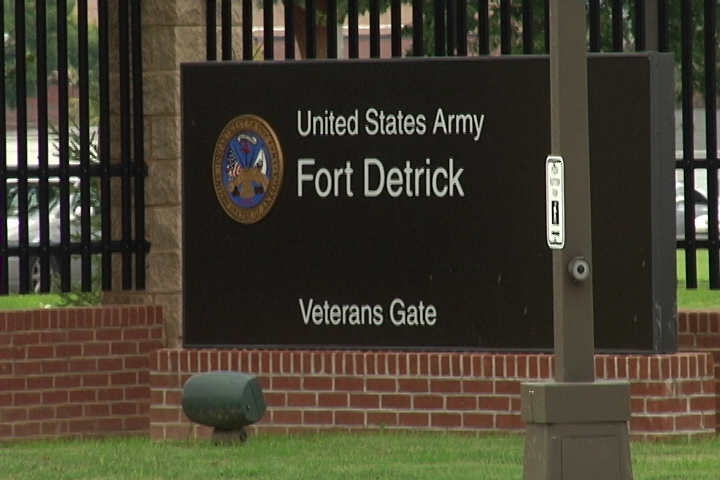WASHINGTON – Current plans for risk assessment of a new biodefense laboratory at Fort Detrick aren’t stringent enough, according to a government-ordered study.
The facility will be used for conducting vaccine and drug research to protect against outbreaks of diseases in the medical countermeasures portfolio.
These agents include: anthrax, tularemia, brucellosis, encephalitis, plague and Ebola.
The National Research Council report said there are holes in the plan to assess the facility’s risk to the community and the environment. The Department of Defense contracted the NRC report through the National Academy of Sciences.
“We reviewed the work plan, and our findings were that, as laid out, it will not lead to a robust estimate of risk,” said Charles Haas, chair of the NRC committee.
Last year, another NRC committee evaluated a similar facility at Fort Detrick, the U.S. Army Medical Research Institute of Infectious Diseases. That report advised the Army to improve its site-specific risk-assessments.
A researcher close to the project said he would give the risk assessment work plan for the new lab a C- if he had to grade it.
The reviewers said the Ft. Detrick risk assessment should have considered offering alternate locations or designs for the facility.
Their report also questioned the plan for focusing only on direct consequences of a “release event” based largely on previous incidents.
“Heavy reliance is placed on examination of retrospective reports of laboratory-acquired infections,” the report said. But it recommended considering potential events.
“A robust risk assessment should proactively assess the likelihood and consequences of potential events,” according to the report. “Unlikely events are not impossible, and it is the unprecedented event that often has resulted in severe outcomes.”
Haas emphasized, “They need to do a more thorough evaluation of the potential events that could occur.”
Other key problems with the risk assessment, according to the report, include:
• Limited range of potential occupational exposures. It addresses risk to lab workers and their contacts, but leaves out administrative, maintenance and waste-handling staff.
• The facility hasn’t yet been designed. Major design changes could increase risk and may require another risk assessment.
• No exploration of indirect consequences. “Indirect consequences may occur as a result of an adverse event, which include economic, social and health care impacts.” They cited the 2001 anthrax attacks as an example. Only 22 people were directly affected, but more than 30,000 people received treatment.
• The references cited are questionable. “Of the 22 references cited in the work plan, eight were not peer-reviewed and three were not appropriately referenced.“
• Veterinarians, not only doctors treating human patients, need to be educated to the risks.
• Pathogen maps used do not explore all potential routes of exposure. They said the maps should include “all plausible sources and routes of exposure,” including waste streams, accidental ecosystem contamination, and wild animals and insects entering the facility and being exposed.
Beth Willis, chair of the Containment Laboratory Community Advisory Committee, said the risk assessment plans have been treated as a formality. “In recent years, that’s how a lot of people have been doing environmental impact statements,” she said. “They’ve been seeing it as a regulatory requirement.”
The NRC committee had similar comments, “An assessment should be viewed not merely as a regulatory hurdle to be overcome but also as a tool to be used to enable the most desirable alternative or policy to be implemented.”
Overall, the plan missed the mark, according to the NRC. ”The committee finds that the methodology of the SSRA is not sufficiently robust to assist the Army in designing a facility that will reduce the risk from potential hazards from the facility’s operations.”
Maryland Sens. Ben Cardin and Barbara A. Mikulski, both Democrats, issued a joint statement Friday urging the Army to carefully consider the committee’s recommendations in order to protect the workers and the surrounding community.
Willis also said she hopes the Army will take the NRC’s recommendations seriously. “That’s a good thing that they’re getting feedback before they’re doing the actual assessment, and we’re certainly hopeful that they’ll take all of these recommendations into account.”
Haas said the Army is not mandated to follow the committee’s recommendation. He said the next step is for Maj. Gen. James Gilman, commander at Ft. Detrick, and his staff to review the report and decide on the recommendations.
Army spokeswoman Lori Calvillo said the Army is “in the process of reassessing the need for the facility and it would be premature to have a detailed discussion until outcomes are available in December.”
Willis said the government has an obligation to inform the people. “The community didn’t have a choice in the labs coming here, but the community has a right to understand how the Department of Defense, and other federal agencies, are defining an acceptable risk,” she said. “That needs to be made clear to us. So far that hasn’t been done, and we hope it will be when this new risk assessment is actually created.”

